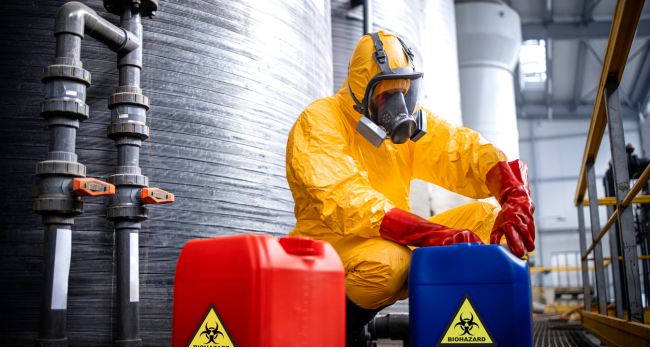Chemical Safety and Hazardous Materials Handling
- Description
- Curriculum
- Reviews
INTRODUCTION:
One of the foundational aspects of chemical safety is the proper identification and classification of hazardous materials. Chemicals can be toxic, flammable, corrosive, reactive, or have other harmful properties. It is crucial to familiarize employees with safety data sheets (SDS), which provide critical information about each chemical’s properties, potential hazards, and recommended safety precautions. Effective labeling and storage are also key to reducing the likelihood of chemical accidents, ensuring that hazardous materials are kept in appropriate containers and areas with the correct safety measures in place.
Personal protective equipment (PPE) plays a significant role in chemical safety, providing an additional layer of protection against potential exposure. Depending on the nature of the materials being handled, workers may need gloves, goggles, face shields, respirators, or specialized clothing to protect against chemical burns, inhalation risks, and other injuries. Proper training in the use of PPE ensures that workers understand how to choose the right equipment and how to use, maintain, and dispose of it safely.
Proper handling and storage of hazardous chemicals are also vital components of a robust safety plan. This includes understanding proper labeling, segregation of incompatible chemicals, and adhering to recommended temperature and humidity controls. Additionally, employees must be trained in safe procedures for transporting chemicals and managing spills, leaks, or other emergencies. Effective spill response plans and containment measures help reduce the environmental impact of accidental releases and minimize the risk of exposure to harmful substances.
In conclusion, chemical safety and hazardous materials handling require a combination of knowledge, training, and preparedness. By understanding the potential risks associated with hazardous materials and implementing appropriate safety protocols, organizations can prevent accidents, protect the health and well-being of workers, and ensure compliance with regulations. Ongoing education, proper equipment, and careful management are essential for maintaining a safe and secure environment in any setting that involves hazardous chemicals.
COURSE OBJECTIVES:
· Understand the principles of chemical safety and how to identify hazardous materials in various work environments.
· Interpret and apply safety data sheets (SDS) for effective risk assessment and proper chemical handling.
· Learn the selection, use, and maintenance of personal protective equipment (PPE) to minimize chemical exposure.
· Acquire skills for the safe handling, storage, and transportation of hazardous substances in compliance with regulations.
· Develop techniques for managing chemical spills and emergencies to protect health and the environment.
· Gain insight into regulatory standards and best practices for ensuring a safe and compliant workplace.
COURSE HIGHLIGHTS:
Module 1: Introduction to Chemical Safety and Hazardous Materials
· Classification of hazardous materials: toxic, flammable, corrosive, and reactive.
· Importance of chemical safety across various industries.
· Overview of key regulatory bodies (e.g., OSHA, EPA) and compliance responsibilities.
· Role of Safety Data Sheets (SDS) in identifying hazards and managing risks.
Module 2: Personal Protective Equipment (PPE) and Safety Protocols
· Purpose and significance of PPE in chemical safety.
· Overview of PPE types: gloves, goggles, face shields, respirators, and protective clothing.
· Guidelines for selecting, using, maintaining, and disposing of PPE.
· Ensuring worker readiness and adherence to PPE protocols.
Module 3: Safe Handling, Storage, and Transportation of Hazardous Materials
· Core principles of safe chemical handling and exposure reduction.
· Best practices for chemical storage, labeling, and segregation.
· Safe transportation procedures and spill prevention strategies.
· Response actions for accidental releases during handling or transit.
Module 4: Spill Response and Emergency Procedures
· Identifying potential spill risks and the need for preparedness.
· Methods for containing, cleaning, and disposing of chemical spills.
· Emergency response for leaks, fires, and explosions involving hazardous substances.
· Evacuation planning and coordination with first responders.
Module 5: Regulatory Compliance and Best Practices for Chemical Safety
· Overview of major chemical safety regulations and enforcement agencies.
· Workplace standards and industry practices for chemical safety management.
· Conducting audits and maintaining documentation for regulatory compliance.
· Developing an effective chemical safety program tailored to organizational needs.
TARGET AUDIENCE:
· Chemical Engineers and Technicians
· Industrial Safety Officers and Managers
· Laboratory Workers and Research Scientists
· Environmental Health and Safety (EHS) Professionals
· Warehouse and Transportation Personnel
· Manufacturing and Construction Workers








